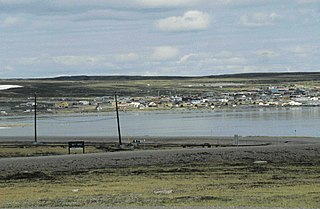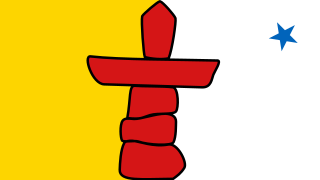
Kittilä is a municipality of Finland and a popular holiday resort.

Baker Lake is a hamlet in the Kivalliq Region, in Nunavut on mainland Canada. Located 320 km (200 mi) inland from Hudson Bay, it is near the nation's geographical centre, and is notable for being Nunavut's sole inland community. The hamlet is located at the mouth of the Thelon River on the shore of Baker Lake. The community was given its English name in 1761 from Captain William Christopher who named it after Sir William Baker, the 11th Governor of the Hudson's Bay Company.
Boliden AB is a Swedish multinational metals, mining, and smelting company headquartered in Stockholm. The company produces zinc, copper, lead, nickel, silver, and gold, with operations in Sweden, Finland, Norway, and Ireland. In 2003, in a major deal, Boliden acquired Outokumpu's mining and smelting assets within zinc and copper. The company name comes from the Boliden mine, some 30 km northwest of the Swedish town of Skellefteå, where gold was found in 1924. It was once Europe's largest and richest gold mine, but has since 1967 been defunct.
Wesdome Gold Mines Ltd. is a mining, exploration and development company based in Toronto, Ontario, focused primarily on gold.
Yamana Gold Inc. is a Canadian company that owns and operates gold, silver and copper mines in Canada, Chile, Brazil and Argentina. Headquartered in Toronto, the company was founded in 1994 and became listed on the Toronto Stock Exchange in 1995, the New York Stock Exchange in 2007, and the London Stock Exchange in 2020. The company became a gold producer after its 2003 re-restructuring in which Peter Marrone took over as chief executive officer and it merged with Brazilian company Santa Elina Mines Corporation. The combined company was able to use Yamana's access to capital with Santa Elina development properties to bring the Chapada mine into production. From there the company combined with other TSX-listed companies RNC Gold, Desert Sun Mining, Viceroy Exploration, Northern Orion Resources, Meridian Gold, Osisko Mining and Extorre Gold Mines which each contributed either a producing mine or a development project that was able to come into commercial production.

Nunavut is the largest and northernmost territory of Canada. It was separated officially from the Northwest Territories on April 1, 1999, via the Nunavut Act and the Nunavut Land Claims Agreement Act, which provided this territory to the Inuit for independent government. The boundaries had been drawn in 1993. The creation of Nunavut resulted in the first major change to Canada's political map since the province of Newfoundland was admitted in 1949.

Preissac is a municipality in the Canadian province of Quebec, located in the Abitibi Regional County Municipality. The village of Preissac itself is located at the north end of Lake Preissac.

The Meadowbank Gold Mine is an open pit gold mine operated by Agnico-Eagle Mines in the Kivalliq district of Nunavut, Canada.
There are different methods by which gold mining companies are ranked. One is by their annual production. Another is by their cash cost per ounce, that is, how much money it costs them to mine the gold. Since gold prices are the same everywhere, companies with lower costs per ounce make more profit. The most common method lists by market capitalization which considers the total value of capital holdings by that company. Also considered when comparing companies is their market capitalization per ounce of gold equivalent which takes the market value and total reserves and resources for each company as well as the price of gold into consideration. The figures for each company can be used to determine the value the stock market gives to each company's reserves on an ounce to ounce basis.

Kittilä mine, also known as Suurikuusikko mine, is a gold mine in Kittilä, in the Lapland County of Finland. The mine is owned and operated by Agnico-Eagle Mines Limited and is located 36 kilometres (22 mi) north-east of Kittilä. Exploration began in 1986, and production started in 2008. The mine is composed of two open pits, with the proceeds of the operation funding an underground mining operation, accessed by a ramp from surface and utilizing both transverse and longitudinal long-hole stoping methods. The mine utilizes on-site concentrating to produce Doré bars for shipment off-site for refinement, and is scheduled to produce 150,000 ounces (4,300,000 g) of gold in 2009.
The Canadian Malartic Corporation is a mining company that operates the Malartic mine near Malartic, Quebec. Prior to 2014 the company was a public company named Osisko Mining Corporation with shares listed on the Toronto Stock Exchange and New York Stock Exchange. In 2014, Osisko Mining was subject to a hostile takeover bid by Goldcorp but an alternative bid by white knights Yamana Gold and Agnico Eagle Mines Limited was accepted that, in addition to offering a higher price, created the spin-off Osisko Gold Royalties and turned Osisko Mining Corporation into the subsidiary company Canadian Malartic Corporation jointly owned by Yamana Gold and Agnico Eagle. From its founding in 1982 until 2006, Osisko Mining bought and sold mineral exploration rights in Quebec, conducting exploration work. The company acquired an interest in the Canadian Malartic property in 2004 and after promising feasibility studies the mine was constructed with commercial production achieved in May 2011.is a Canadian company engaged in the exploration and development of several mineral properties in Quebec.

The Abitibi gold belt is a region of Canada that extends from Wawa, Ontario to Val-d'Or, Quebec. Located within the mineral-rich Abitibi greenstone belt, the gold belt is an established gold mining district having produced over 100 mines, and 170 million ounces of gold since 1901. Timmins, a town founded in 1912 following the Porcupine Gold Rush and subsequent creation of the Hollinger, MacIntyre and Big Dome Mines, is one area in the region that experienced a gold rush beginning in 1909. The Kerr Addison Mine in Virginiatown was at one time Canada's largest gold producing mine. Many of the towns readily acknowledge gold mining as part of their history, some being named after gold. One of Canada's 'large roadside attractions' is a 12-foot replica of a 1908 gold sovereign built to commemorate Canada's first gold coin which was made using gold from the Kerr Addison mine.

Orex Exploration is a former Canadian gold mining company that conducted exploration work on mining properties it owned in the Goldboro and Guysborough County areas of Nova Scotia. The properties owned by Orex were the sites of the former Boston Richardson Mine, Dolliver Mountain Mine, West Goldbrook Mine, and East Goldbrook Mine which operated between 1892 and 1912. Headquartered in Rouyn-Noranda, Quebec, the company was founded in 1987 and raised funds for exploration work, in part, by issuing stocks traded on the Montreal Stock Exchange and then the TSX Venture Exchange. It became a subsidiary of Anaconda Mining Inc. after Anaconda acquired the company in a stock swap deal in 2017.
Queenston Mining, Inc. was a Canadian resource company focused on the exploration and development of gold deposits on “Proven Mine Trends” in geopolitically stable areas. The objectives of the Company were to expand upon its exploration areas to enlarge existing deposits and to target new discoveries, and to return to producer status through the development of its 100% owned properties.

Guyana Goldfields is a Canadian company that owns and operates the Aurora gold mine in Guyana. It is a publicly-traded company with shares listed on the Toronto Stock Exchange and previously TSX Venture Exchange. Beginning in 1996 the company acquired exploration rights to the former Peters and Aurora mines with the objective of utilizing modern exploration technology to re-evaluate the potential gold reserves. Following positive exploratory results, the company received financing from the International Finance Corporation and other investors and conducted economic and technical feasibility studies. The Aurora gold mine began commercial production in 2015 and has produced approximately 125,000 to 160,000 ounces of gold per year from the mine since then. These lower than expected results and a revised technical study that significantly lowered the recoverable reserves estimates, led to the removal of the CEO and directors involved in making the investment decision and a class action lawsuit alleging misrepresentations in public disclosures.
Osisko Gold Royalties Ltd is a Canadian company that holds royalties in gold, silver and diamond mines, principally in the form of net smelter returns and streams. The company also invests in mineral exploration companies in the form of purchases of shares. Like its predecessor company, Osisko Mining, it is headquartered in Montreal, Quebec, with shares listed on the Toronto Stock Exchange and the New York Stock Exchange.

The Meliadine Gold Mine is a gold mine near Rankin Inlet in the Kivalliq district of Nunavut, Canada. It is expected that the mine will have two underground components and twelve open pits. The mine is operated by Agnico-Eagle Mines and is projected to be in operation until 2032.

The Canadian Malartic Mine is a gold mine 25 kilometres (16 mi) west of Val-d'Or in Quebec, Canada. It is the largest operating gold mine in Canada.

The LaRonde Mine is a gold mine 62 kilometres (39 mi) west of Val-d'Or in Quebec, Canada.












